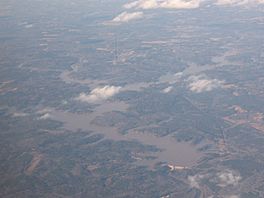Jackson Lake (Georgia) facts for kids
Quick facts for kids Jackson Lake |
|
|---|---|

Lloyd Shoals Dam and Jackson Lake
|
|
| Location | Butts / Jasper / Newton counties, Georgia, United States |
| Coordinates | 33°22′05″N 83°51′20″W / 33.3680°N 83.8555°W |
| Lake type | reservoir |
| Primary inflows | Yellow, Alcovy, South rivers; Tussahaw Creek |
| Primary outflows | Ocmulgee River |
| Basin countries | United States |
| Surface area | 4,750 acres (19.2 km2) |
| Max. depth | 94 feet (29 m) |
| Shore length1 | 217 km (135 mi) |
| Surface elevation | 161 m (528 ft) |
| 1 Shore length is not a well-defined measure. | |
Jackson Lake is one of the oldest man-made lakes, called reservoirs, in Georgia, United States. It's about 44 miles (71 km) southeast of Atlanta in a rural area. The lake is located in parts of three counties: Jasper, Newton, and Butts.
The Lloyd Shoals Dam was built in 1910 by the Central Georgia Power Company. It was first used to create electricity for the city of Macon. Jackson Lake is smaller than some other lakes in Georgia, covering about 4,750 acres (19.2 km2) with 135 miles (217 km) of shoreline. It still makes electricity today. It's also a popular spot for water sports, boating, wakeboarding, and fishing.
Jackson Lake is formed where three rivers meet: the Yellow, Alcovy, and South rivers. Tussahaw Creek also flows into the lake. Below the Lloyd Shoals Dam, the water flows out into the Ocmulgee River.
Building the Lloyd Shoals Dam
In 1907, a man named Jordan Massee, Sr. and his partners bought a power company. They soon renamed it the Central Georgia Power Company. This company bought the land for the dam from Captain William F. Smith, who lived in Butts County, Georgia. He had always wanted a power facility built there.
The power company hired a group led by Theodore Ellis to clear the land where the lake would be. Many local farmers had to move from their homes and rich farmland. Because the area was rural, there were no hotels. So, the workers had to sleep in tents while they built the dam.
Even during a time when the economy was not doing well, Jordan Massee was able to get money for the project. He convinced a company from New York to support it. He even arranged for 200 bankers from the northern U.S. to visit the dam site. He took them on a private train car to Macon and then to the dam. There, he hosted a big barbecue with 14 pigs! He also showed them the dam site where construction had already begun.
Many bankers decided to invest in the project. Even a representative from the Bank of Scotland and a son of an English nobleman invested.
After getting enough money, the power company hired David W. Hilliard to manage the construction. Hundreds of men worked in two shifts, with one shift working through the night. The company built wooden cabins for the workers to live in. Getting supplies to the building site was a big challenge.
In 1911, the Lloyd Shoals Dam was finished. It was 100 feet tall and 1,070 feet long. Power lines were put up to send electricity to cities like Macon, Forsyth, Griffin, Barnesville, and Jackson.
The lake filled up slowly. At first, there were pools of still water, which caused a lot of mosquitoes. This led to an outbreak of malaria, making more people leave the area. Even after the lake was full, the water was red and muddy from the clay soil. However, having electricity brought new businesses to Jackson and rural Butts County, helping the economy grow.
When it was first built, the dam had four units that each generated 2,400 kilowatts of power. In 1916 and 1917, two more units were added. This brought the total power output to 14,400 kilowatts. With improvements over the years, the dam can now generate up to 21,000 kilowatts.
In 1928, Georgia Power bought the Central Georgia Power Company. For many years, Georgia Power had staff at the dam for maintenance and power generation.
Over time, the muddy lake cleared up. It became a popular place for fun and relaxation. Many fishing camps opened along its shores.
In 1978, the dam became part of the Central Georgia Power Group. It is the only dam in that group located on the Ocmulgee River.
In January 1983, a fire badly damaged the powerhouse, which is the building where electricity is made. It was rebuilt the next year. Most of the electrical equipment and wiring had to be replaced. The fire did not harm the dam structure itself. The repairs cost $2.8 million.
Today, the Lloyd Shoals Dam is maintained by workers from the nearby Wallace Dam.
Fun Activities at Jackson Lake
Fishing
Jackson Lake is home to many kinds of fish. You can find white catfish, bullhead catfish, channel catfish, blue catfish, black crappie, white crappie, redear sunfish, redbreast sunfish, bluegill, spotted bass, largemouth bass, striped bass, and hybrid bass.
- at GNIS



